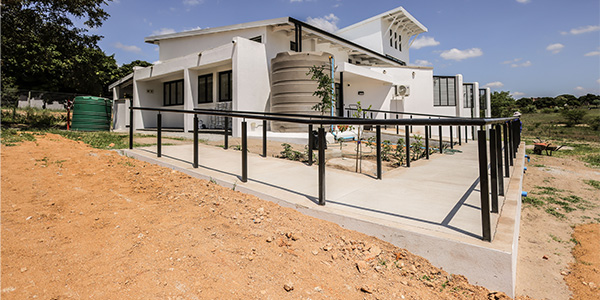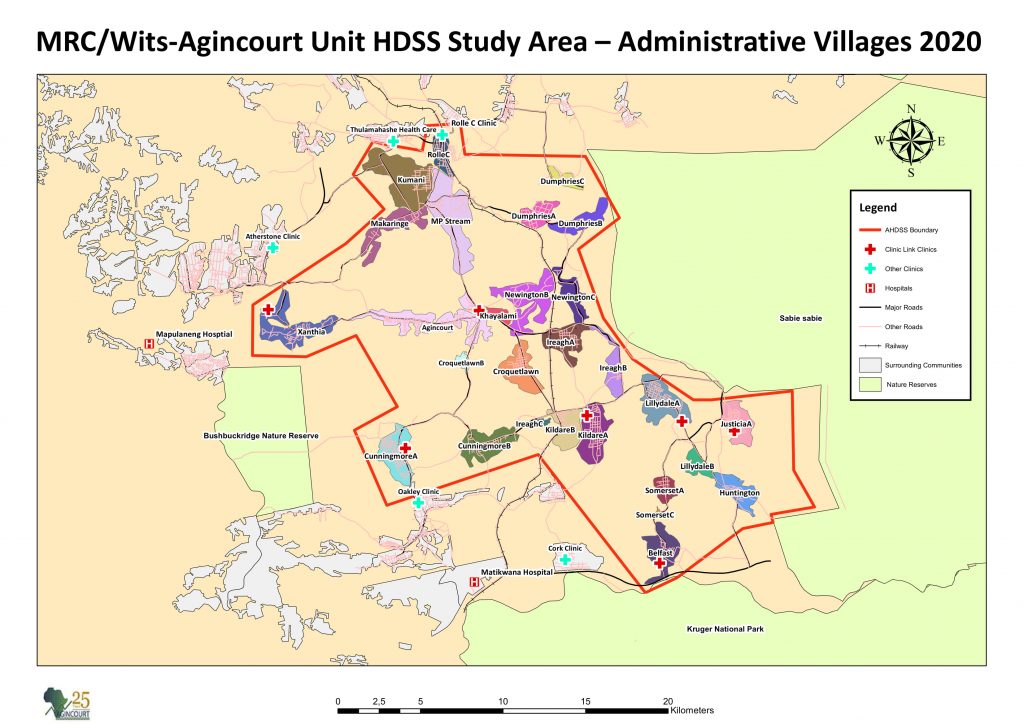This is not just a building ...
- Wits University
The new Data Sciences and Innovation Hub at Wits Rural Campus marks 30 years of rural public health research and sets the scene for an innovative epoch in 2023.

The officially named Medical Research Council (MRC)/Wits Rural Public Health and Health Transitions Research Unit (Agincourt) is nested both in the Wits School of Public Health in Johannesburg and at the Wits Rural Campus and Wits Rural Knowledge Hub (WiRKH) in the towns of Agincourt [Matsavana] and Acornhoek [Khenhuk] in Bushbuckridge, Mpumalanga – abutting on the Kruger National Park and adjacent to the border with southern Mozambique.
Agincourt and over 30 surrounding villages is the Wits research site where 21 000 households comprising some 120 000 individuals have generously participated in public health and health transitions research since the late 1980s.
The sophisticated health and demographic surveillance system (HDSS) provides a platform for generating big data that leads to new knowledge and presents opportunities for testing innovative methodologies using the latest technology.
Most people in SA live in rural areas but just as many are in constant motion. The rural and urban populations in this country are inextricably bound. Understanding a nation in flux in the 21st century, and its impact on health, is the crux of research at Agincourt and critical to advancing public and population health.
‘This is a gateway. This represents opportunity.’
It is within this context that a new, state-of-the-art, 21st century Data Sciences and Innovation Hub opened at Agincourt on 22 November 2022. The Data Hub is poised to crunch the numbers that will catapult rural public health into scientifically informed and tailored interventions and policies that respond to South African rural community needs directly.
“This is not just a building. This is a gateway. This represents opportunity. It represents a chance to link up with others. Because I think the power of data centres is how data all connects. Data is the new gold,” said Professor Lynn Morris, Deputy Vice-Chancellor: Research and Innovation, at the opening.
“I’m very excited about this – the building, of course! – but actually the opportunity that this building represents, because there’s also going to be young people trained here. That’s another exciting thing about data science, that young people have a natural affinity for working with data.”
‘Data is the new gold’
Leading the charge on big data at Agincourt is Dr Chodziwadziwa ‘Cho’ Kabudula, Assistant Director: Data and Analytics. Kabudula’s research interest is the application of demographic, statistical, computational and informatics techniques to investigate population-level morbidity, mortality, and utilisation of health services, together with their social determinants.
Speaking at the opening, Kabudula said that the new Data Hub reflects research data infrastructure and the transition from paper-based to tablet, online and telephonic research. Indeed, the Hub will also serve as a call centre from which critical data are sourced telephonically, he said.
“What’s next? We’ll be able to harness data from mobile apps and other new sources and find digital solutions to treat and manage disease conditions and preserve health,” said Kabudula – with whom Agincourt data is in good hands, given that his expertise in linking records and integrating data was demonstrated in a paper he co-authored and published in the International Journal of Population Data Science in 2022.
Thirty years ago, however, the expertise and access to the big data required for population health and migration was sorely lacking – particularly in a country where the state legislated the exclusion of the majority.
GEARing-up for rural public health
It was in 1979 that Wits University first established a presence in Bushbuckridge. Professor John Gear, Head of what was then the Department of Community Health, had introduced the concept of primary healthcare at the University. He established the Health Systems Development Unit (HSDU) at Tintswalo Hospital in the former homeland of Gazankulu (now much of Mpumalanga) so that Wits could teach ‘rural health.’
Two young doctors, Stephen Tollman and Kathleen Kahn, graduated from Wits Medical School in 1984. They had been undergraduates in Gear’s Department and were already immersed in rural public health at Tintswalo Hospital. From 1988 to 1990, they pursued postgraduate studies and research at Harvard University. They returned to SA and pitched the idea to their mentor, Gear, of establishing a health and demographic surveillance unit in the Tintswalo-based HSDU. Gear says he served as “a kind of remote mentor from around 1979 to 1990” for Tollman and Kahn when “it gave them a bit of credibility to have a senior Wits academic who bought into the idea.”
“Never say no!” said Gear at the Data Hub opening, 30 years later – which is what former Vice-Chancellor Dr DJ ‘Sonny’ Du Plessis (1978-1983) had advised if presented with a brilliant idea, that Gear said he is “so proud to be half-alive enough to witness!”
Who dies from what?
Speaking at the Data Hub opening, Tollman lamented the dearth of rural public health data back in the early days of Agincourt. Despite early (and enduring) support from public sector partners such as the Department of Health (DoH) and the South African Medical Research Council (SAMRC), accurate information simply didn’t exist in the early ‘90s.
“My feeling is that the MRC was very urban-focused, somewhat inward looking. But over time the MRC has become a very important partner, one that we value extremely highly in the course of the evolution of Agincourt,” said Tollman at the Hub opening.
Tollman and Kahn led the establishment of the Agincourt Field Research Centre in the 1990s, with a view to generating population-based data based on long-term health and socio-demographic surveillance. They counted people and households and established these individuals’ birth-life-death data – and they have continued to do so for three generations.
“We realised that people did not know an awful lot [in the 1990s]. We counted the number of people [living in Agincourt] and it was twice the number of people we were told lived in this kind of community. And this issue of who dies from what – so fundamental to building a healthcare system, a social system – was really ignored,” recalls Tollman.
On that basis, the Agincourt health and socio-demographic surveillance site effectively put 21 000 rural households on the map – literally.

Today the empirically derived mortality and cause-of-death series informs work on chronic conditions across the life course and is among the richest on the continent.
“We’ve been able to establish what’s needed both observationally, and in terms of evaluations, trials and various other opportunities, to contribute to development of this Bushbuckridge local and South and southern African environment,” said Tollman.
Community, people, and partnerships
Central to the success of Agincourt over 30 years has been the establishment of deep and enduring relationships. From the outset, the people of Bushbuckridge (represented by a Community Advisory Board), the DoH, the SAMRC, donor-partners, and Wits University itself contributed, collaborated, and committed to advancing rural public health through Agincourt.
“Steve has spoken about the health systems research and development as part of our origins, but what this meant was the very, very strong relationships that were developed as part of that with our public sector stakeholders – in the first instance, the Department of Health, sub-district, district, and provincial level,” said Kahn at the opening. “And those partnerships have been key and integral to our sustainability and have extended from the Department of Health, to Education, and the Department of Social Development.”
Mr Ishmael L. Mtungwa from the DoH attended the opening on behalf of District Management. Speaking at the event, Mtungwa confirmed that the “collaboration” with Wits Rural Campus dates back decades and that the DoH chooses to call it a “relationship” and a “community of property”. He lauded the relevant and critical data that Agincourt communicates to the DoH and said that “the DoH will take advantage of this Hub to use tested data.”
“This unit is curious. It seeks to discover and create solutions. It seeks to invent the next big thing that will assist the Department. We brag – and we will continue to brag – about the Wits Rural Facility. It continues to put us on the map. Bushbuckridge is known across the world. Continue to be curious!” said Mtungwa.
Construction of the Data Hub specifically was funded by Campus Planning and Development at Wits, the Beare Foundation SA, and the Wolfson Foundation in the UK.
Mr Julian Beare, Executive Trustee of the Beare Foundation, wrote: “I have been very fortunate to have been involved in the development of the Agincourt complex over the last 12 years or so. I am especially pleased that the opening of the Agincourt Data Sciences and Innovation Hub corresponds with the centenary celebrations of Wits University. It is projects such as these that underscore the high standard and quality of our universities and the people of South Africa.”
Mr Paul Ramsbottom, CEO of the Wolfson Foundation, wrote: “We hope that the building which we have helped to fund – housing additional data gathering and analysis capabilities – will enable you to uncover new insights and intelligence, underpinning the efforts of researchers, practitioners and policymakers as they seek to improve individual well-being, population health and national prosperity in South Africa.”
Speaking via video-call at the Hub opening, Vice-Chancellor and Principal, Professor Zeblon Vilakazi, said: “The opening of the Agincourt Data Sciences and Innovation Hub is timeous and necessary. Agincourt celebrates its 30th in 2022 as Wits University celebrates its centenary. To Professor Steve Tollman and Professor Kathleen Kahn, the ‘architects’ of Agincourt … the people in the community who participate in your research, the postgraduate students you nurture, your extensive network of local and international partners, congratulations on this Data Sciences and Innovation Hub that will take Agincourt’s already excellent research into the next century."
